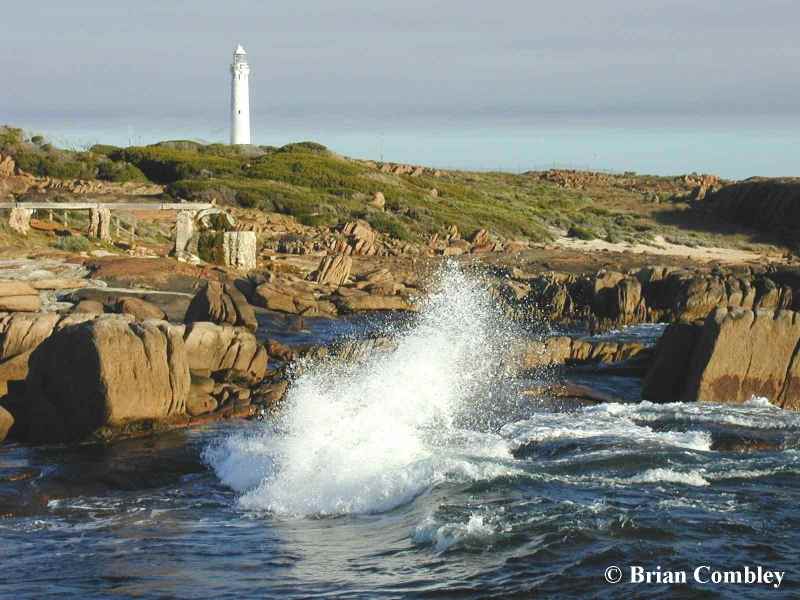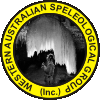Augusta
Climate.
Tourism.
Cosy Corner.
Leeuwin Lighthouse.
Leeuwin Water Wheel.
General Cave Information.
Augusta Cave Descriptions
The Augusta area boasts some of the most well decorated and longest caves in W.A. Covering an area over 16 km long from Cape Hamelin in the north to Cape Leeuwin in the south, the Augusta caving area, designated AU, contains a belt of coastal limestone consisting of Pleistocene deposits laid down during glaciation periods. Some characteristics of the aeolianite are sharp jagged limestone which has been greatly eroded by high rainfall, very heavy vegetation (Karri Eucalyptus diversicolor), heavy undergrowth and many speleological features and caves.
Climate.
The climate here is Mediterranean, humid and receives a high annual rainfall followed by a short summer drought. Temperatures often rise to 35 degrees and warmer during the summer, so if you can't keep your cool in the caves every day, the local beaches offer a pleasant diversion for even the most dedicated caver.
Tourism.
Tourism is an important industry of the Leeuwin Naturaliste Ridge, so if you can spare a day from caving, go touring as there is a lot to see. Within the Augusta area are:-
Cosy Corner:
A great beach, sheltered and ideal for children. While you're there, check out the limestone outcrop on the beach to the south of the car park. It contains many blowholes spurting water up to six metres on rough days.
Leeuwin Lighthouse:
Built in the 1890's by M.C. Davies and Co. entirely out of local limestone, it is the tallest lighthouse in W.A. Check at the lighthouse for inspection times.
Leeuwin Water Wheel:
Built in the 1800's to supply water to the lighthouse and Augusta, the wheel is now completely covered in calcite from the spring which once flowed over it. No cave has been found for the Leeuwin Water Wheel Spring (AU 26) so if you have time take a look,......
There are many more places to see both in the Augusta area and in other parts of the Leeuwin-Naturaliste Ridge, for example, Cape Naturaliste, Yallingup Beach, Canal Rocks, Sugarloaf Rock, Prevally Park and Boranup Beach. For more information see the Augusta- Margaret River Tourist Bureau in Margaret River.

Photograph of the Leewin Lighthouse and water wheel by Brian Combley.
The caves.
There are 29 known speleological features and caves in the Augusta area. The possibility of finding more is certain, the only limiting factor being the dense forest around them and the generally small entrances to the caves. Most of the caves have solution pipe entrances, and a few have large collapse entrances. The caves are nothephreatic and can be divided into two categories:
1. Caves reaching the water table: These caves are complex in their layout. There are three caves in this category, namely Easter, Jewel, and Labyrinth. If one looks at the walls, ceiling and formations of these caves, it can be seen that the rise and fall of the water table has been considerably responsible for their formation. The depth of these caves is approximately 44 metres at water level. They are all heavily decorated, predominantly with straws. They have many complex interconnecting passages. They all show a vague north-east trend due to the underlying Pre-Cambrian gneiss. One common feature of these caves is that they are multi- level, having as many as four different levels. It is these levels that explain the presence of caves not reaching the water table.
2. Caves not reaching the water table: These caves are generally much smaller and are usually vertically developed, for example, Harley's Cave and Bat Cave. These caves are surely consolidated for extension into bigger systems as they are probably remnants of higher water levels. As cave development would still have occurred while the water level fell, it is possible that there are small tunnels, now blocked by soil, which lead to lower levels. Evidence supporting this is the discovery of Easter Cave. Originally a small sand floored chamber, digging at the lowest point broke into a system over 7 kms in length at a lower level.
Formations in the caves. Straws and helictites are the most common type of formation to be found in the caves of Augusta. In such caves as Easter Labyrinth and Jewel, there are literally thousands showering from the ceilings, some reaching up to four metres in length. Some are completely transparent and almost all are active. They present a challenging task to photographers.
Helictites in amazing forms are to be found in Easter Cave where some grow horizontally out from the wall for more than 60 cm. Excellent displays of columns and stalactites can be seen in most of the Augusta Caves. Old Kudardup possibly has the best display, its columns being over 18 metres high. Large formations such as these are particularly common due to the high rainfall and humidity. They are nearly always found in the upper levels of the caves.
Calcite crystals can be seen in three of the caves. Jewel Cave has some fine crystal pools which can be seen on inspection of the cave. Deeondeeup which is part of Jewel Cave has the best display. Here a wall of the cave some 18 m high is completely studded with crystals up to 10 cm in length. Easter Cave has Tiffanys, an old crystal pool 4 m long and 1 m deep. Crystals up to 10 cm cling to all sides of the pool.

